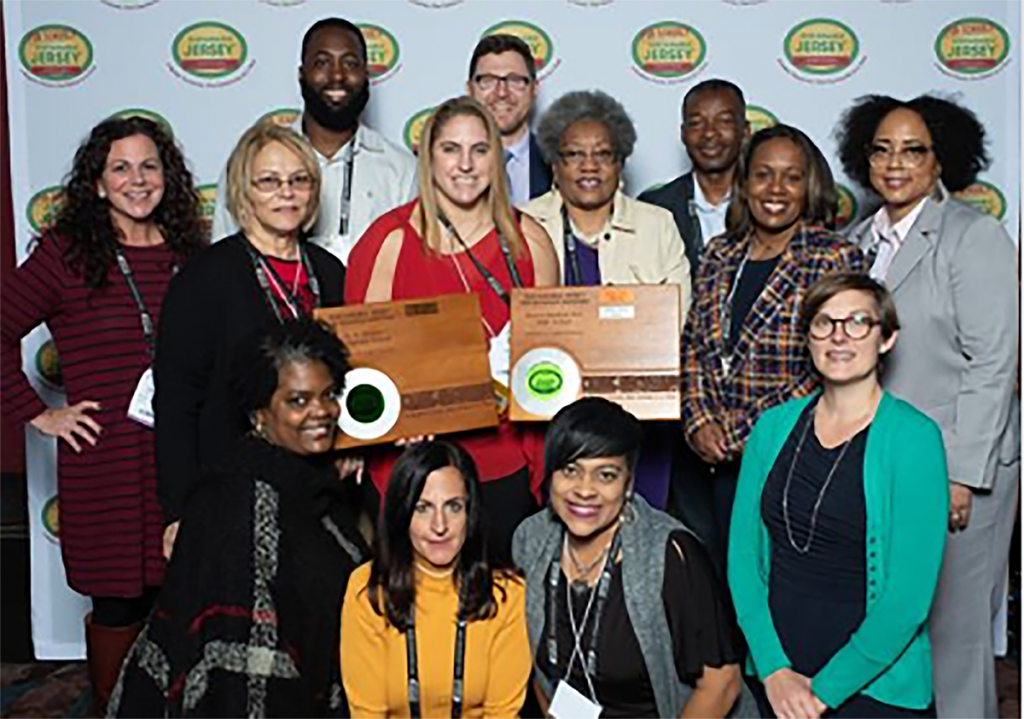By. Jill Buck
Is the Green Schools Movement Equitable?
I don’t believe that any group involved in the green schools movement is intentionally insensitive to communities in Environmental Justice (EJ) areas or food deserts. I do believe that leaders of the movement could do more to ensure that schools in these communities have the requisite resources to bring the benefits of the green schools movement to their students. Many organizations track how many schools in their network are Title I schools. This is excellent, but I ask you to consider adding new metrics to your program evaluations. While we devote time and resources to low-income students, let’s recognize that children who bear the burdens of poverty, pollution, AND food insecurity need an outpouring of support from those of us who seek to protect them from environmental pollution and degradation.
The Go Green Initiative (GGI) Board of Directors has a simple litmus test for our annual budget, and our staff applies the same test to our program scheduling: where you spend your time and money reveals what you truly value. We value protecting children’s health from environmental pollutants and conserving natural resources for future generations. So when we set our budget and create our weekly, monthly, and annual calendars, we ensure there’s money and time allocated for the schools and districts that need our resources most. If this approach appeals to you, these are some questions you might consider:
When your organization is setting standards for what it means to be a green school, do you allocate staff time to help schools in EJ and food desert communities meet these standards?
Example in an EJ community: GGI has a program to help schools use the Energy Star Portfolio Manager to track and reduce their energy, water, and waste. We teamed up with one of our sponsors to offer paid summer internships for 16 high school students in Compton, Oakland and Hayward, California to help them work with their school boards, district staff, and site administrators to enact energy conservation policy that will include use of Portfolio Manager (Link to interns’ presentation on YouTube).
When your organization is raising funds for operations, do you include budget line items for flow-through money to seed projects that help schools in EJ and food desert communities reach sustainability standards?
Example in a food desert: GGI encourages schools to use locally grown and organic food, but in a food desert that’s very difficult. We worked with high school students, their science teacher, and principal to develop a presentation for the school board and city council to gain permission to build a greenhouse to start growing food. The students’ goal is to provide plants that will spawn multiple community gardens where residents can grow healthy fruits and vegetables. We teamed up with one of our sponsors to provide a $4,500 grant to help get the greenhouse going.

Do you spend time helping schools/districts in EJ and food desert communities find and write grants to support their efforts?
Example in an EJ and food desert community: GGI has worked with the Newark (New Jersey) Public School District since 2013. One of their goals is to create a district-wide recycling program for all 61 schools in the district. We helped identify and co-write a $10,000 grant from Sustainable Jersey for Schools and Public Service Enterprise Group, then asked one of our sponsors to provide $25,000 as seed money for recycling bins and signage.
Case Study of Success: Camden City School District
Camden, New Jersey is one of the largest cities in the state and nearly 40% of its population lives below the poverty line. Camden is both a U.S. Environmental Protection Agency (EPA)-designated EJ community and a U.S. Department of Agriculture (USDA)-designated food desert.
When GGI began working in the Camden City School District in 2015, the district was facing steep fines from the county Department of Environmental Protection for non-compliance with state recycling laws. By 2017, they earned the New Jersey Department of Environmental Protection Rising Star Award for their exemplary district-wide recycling program. In 2018, Camden City School District’s Brimm Medical Arts High School earned Bronze Certification in the Sustainable Jersey for Schools program.

During the 2018 – 2019 school year, Deborah Goodman, Brimm’s Operations Manager, helped additional schools earn points in the Sustainable Jersey for Schools program. By the end of the school year, H.B. Wilson Elementary earned Bronze certification and Brimm Medical Arts High School went on to earn Silver, as well as recognition as the highest scoring high school in the state of New Jersey! In February 2020, Deborah Goodman was named a Sustainability Hero by Sustainable Jersey for Schools.

The Problem with a Mostly-White Green Schools Movement
It’s no secret that traditionally white environmental activist groups haven’t been historically viewed by communities of color as advocates for environmental justice. Campaigns to protect wildlife and open spaces have often contributed to the clustering of polluting industries in communities of color. It’s not a great leap of causation to say that this led to the creation of EJ and food desert communities in the first place. Dr. Robert Bullard, Distinguished Professor at Texas Southern University, noted this schism in his book, Dumping in Dixie: Race, Class, and Environmental Quality:
“[Environmental] activists tend to be drawn disproportionately from the upper middle class…The large black population of the nation’s inner cities…do not see the mainstream environmental movement as a vehicle that is championing the causes of the…oppressed.” (Bullard, 1990)
I fear this same disconnect permeates the relationship between the green schools movement and schools in EJ communities and food deserts. When school district leaders in EJ and food desert communities look for templates to create policy around environmental or sustainability topics, the examples advanced by various groups in the green schools movement often fail to differentiate between resources of affluent suburban schools that have been largely insulated from air, water, and soil pollution, and those of schools saturated in industrial effluent. Moreover, many of the organizations publishing guides, webinars, and frameworks for sustainable schools devote no demonstrable time or money to help the most resource-deprived schools meet their standards. Even among state school boards associations, the sustainability-related policy templates that are offered may be unattainable for the EJ and food desert school communities in their state, unless additional resources are made available.
Learn More About EJ and Food Desert Communities Near You
EPA’s website has a mapping tool with eleven environmental indicators that are measured in every location in the country. Anyone can access the tool and use it to identify nearby EJ communities.
USDA’s website has a mapping tool that provides food access data for populations by census tract. The tool is available to anyone.
My Top Pick for Budget-Strapped School Districts: Sustainable Jersey for Schools
Regardless of what state you live in, I recommend looking at Sustainable Jersey for Schools. It’s one of the most fully comprehensive programs available, and it’s entirely free. What’s more, schools in EJ and food desert communities will find many of their existing efforts to provide services to students, if properly documented, could help them achieve the same green school awards, recognition, and grants as more affluent schools that currently dominate the attention of the green schools movement. I recommend that economically-challenged school districts place the needs of their students and their community at the vortex of their sustainability planning. If your budget doesn’t allow for a dedicated sustainability manager, you can still create measurable environmental benefits for your students.
Child-Centric, Budget-Friendly Sustainability Planning
Whether or not you can compete for certification, following the guidance of the action items included in Sustainable Jersey for Schools will benefit your students right away. These are some of my top picks for budget-constrained school districts that want to create healthy, clean environments for their students in short order:
Nutrition
If childhood obesity is high in your school district and you want to promote a healthy lifestyle for your students, Sustainable Jersey for Schools offers guidance on Healthy Food Choices Beyond the Cafeteria, Breakfast After the Bell, and Policies to Promote Physical Activity.
Air Quality
If you have a high number of students with asthma and air pollution is a problem in your community, I recommend Indoor Air Quality Review, Anti-Idling Education and Enforcement, Reporting Process for Indoor Air Quality Concerns, and Outdoor Air Quality Awareness Program.
Water Pollution
If water pollution is an issue in your school, Access to Healthy Water in School is a great place to start.
Teamwork
If you want to ensure that you have a strong, well-rounded team of people working on sustainability topics in your school district, use these action items for the best results: Green Team, Diversity on District Task Forces and Committees, School Wellness Council, and Accessible Communications.
Their Future Starts Today
The green schools movement needs a greater sense of urgency. Schools in some zip codes are going to need more attention and resources than others, and it’s incumbent upon experts in school sustainability to seek out and deliver those resources to schools most impacted by pollution and poverty. The Intergovernmental Panel on Climate Change reports that we have ten years to make substantive changes to stave off the worst case scenario of climate change (i.e., before today’s third-graders graduate from high school). If you believe that environmental education should lead to quantifiable environmental improvements that protect children’s health, you’re not alone. If you need assistance finding resources to help you achieve that goal in the context of your community’s challenges, there are organizations like GGI that are eager to help. No child should be excluded from the green schools movement. It’s time for all child advocates to unite to alleviate the burden of environmental injustice and food scarcity. Only then will we have a movement that’s truly sustainable.
“All Americans have a basic right to live, work, play, go to school, and worship in a clean, healthy environment.” (Bullard, 1990)
References
Bullard, D. (1990). Dumping in Dixie: Race, Class and Environmental Quality. New York, NY: Routledge.
Author Bio
Jill Buck is founder of the Go Green Initiative, a 501©3 that is the global leader in environmental education, operating in all 50 U.S. states, 73 countries, and on five continents. In 2004, Jill established Buck Consulting, which helps businesses “go green” and achieve profitability through sustainability. Jill is the host of “Go Green Radio,” a weekly program on the U.S.’s largest Internet talk radio station, www.VoiceAmerica.com, and is co-author of the book, 47 Things You Can Do for the Environment. Jill is an alumna of the University of Illinois and, after graduation, was commissioned as a Naval Officer. Jill holds a M.S., Ed. with a specialty in online teaching and learning.

